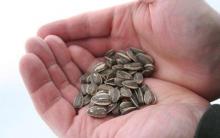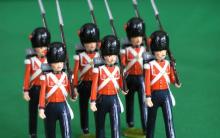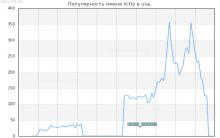My regular readers, especially those who follow news on Facebook, have probably already noticed my love for. In any incomprehensible situation, someone goes to bed, and I go to the beach :) Although, of course, in Holland the sea is not only a beach, but also an important part of the history and life of the country. And to find out more about this, we went to the National Maritime Museum - also known as the Shipping Museum - in Amsterdam!
Many people who trust old guidebooks are still convinced that the Shipping Museum is closed for reconstruction. In fact, it opened again in 2011 - and it stands so beautiful, waiting for visitors :)

![]()
You don't have to wait long for us - we are already there! Here in such a huge courtyard of a monumental building, which, for me, is an excellent attraction in itself. The museum building was built in 1656 - and for many years there was a warehouse for the Dutch navy.

Now under one roof of the museum there are 11 exhibitions that tell about different aspects and periods of the “maritime history” of Holland - from whaling to modern life in the Amsterdam sea harbor. Yes, and the roof itself is huge, glass - by the way, wow! :)

By the way, here is a fascinating story about the building and the roof of the museum from certified guide Katya Bartels: “ The museum building is a former military warehouse and arsenal of the Amsterdam Admiralty, built in the mid-17th century. The main warehouse of Amsterdam is built on water and consists of four buildings connected to each other in the shape of a square. The courtyard is the central hall of the museum and, before reconstruction, was completely open and had no roof.
Two years ago, a transparent glass ceiling was built over the hall. The main task of the architects was to build a roof without additional supports in the middle of the hall. The roof had to be airy and not disturb the space, allowing visitors to see the sky while indoors. The task was successfully completed!
Glass triangular sheets were placed on steel longitudinal arcs, thrown in different directions between the buildings, symbolizing the lines drawn on map projections. The entire structure consists of 6,000 steel arcs connecting 1,200 glass triangles, and weighs 200,000 kilograms, which is equivalent to the weight of 50 elephants».
Well, let's see! First of all, we went to the exhibition of ship decorations. Many of them are real works of art, full-fledged sculptures, thought out and polished to the smallest detail. Like these ones.

And even these :)

In a separate room there are ship models. Before going to the museum, I read reviews on TripAdvisor and saw several comments about how “sad to see the halls empty.” Well I do not know. The huge halls below and on the floors of the building are really empty - but it would be strange if the exhibits stood right in the corridors and on the staircases.
And in the exhibition halls, as you can see, everything is placed quite tightly. Next to each ship model there is a number and only a short description. If you want to know more, you need to move the multimedia screen towards the ship ( he “rides” along the glass wall) – and read on it what’s what.

And here is the equipment that helped ancient ships find their way.

The Maritime Museum has a large collection of atlases. An interesting fact: when you enter the room with atlases, you find yourself in twilight. The light here is barely burning. This is how the museum protects ancient atlases from fading. But next to each exhibit there is a button: when you press it, a light comes on, illuminating the pages.

Would you like to look through the atlas? With the original, of course, it’s difficult to organize this - but you can go up to the huge screen and look at the scans of the pages on it. If you particularly like something, you can immediately send these pages to yourself by e-mail. For example, I decided to keep an old map of Haarlem as a souvenir. A couple of minutes - and here she is, mine forever :)
One of the museum's exhibitions is dedicated to modern trade and the work of the port. You can find out which goods are delivered from which countries to Holland (here, for example, Brazilian coffee, and just below are the wonders of Chinese industry:). Here you can watch films about the work of the port, customs and other maritime services in Holland today.


And you can also... go into the “container”, feel like a cargo and see with your own eyes the entire logistics path from landing at the airport to being put on the store shelf! The number of different interactive things in the museum is very impressive!
In several halls of the museum there is a large collection of paintings on a marine theme. Of course, I wasn’t very successful in taking a photo of this painting, but I want to show you something. There's a picture hanging on the wall.

And next to it there is a large screen with a touchscreen. And you can click on some elements of the picture (there are circles there, see?) - and learn more about its plot. By the way, this is quite a popular thing in museums in Holland. Yes, they even bring interactivity to paintings with a centuries-old history!

Tsar Peter also appeared here.

The collection of paintings itself includes both ancient and modern works.

The museum also has special exhibitions and areas for children. Adults are also allowed in! :) For example, you can go into the mouth of a whale (and then at a separate stand you can see what they find in its stomach, brrrr). Or you can listen to sea stories that actors tell for children (they are broadcast through a projector directly on the walls, in Dutch with English subtitles).

By the way, the children's part of the museum was the most crowded - there, guides or teachers led several groups at once, talking about great naval battles, and about the Dutch East India Company, and about how Holland “reconquered” its lands from the sea.
Remember, in the first photo there was a ship near the museum building? It also contains part of the exhibition, but, unfortunately, we were not able to get there - due to the weather (I have never seen such wind in my life!) the ship was closed.

But the Stalpaert restaurant was open! :) Very nice, with huge floor-to-ceiling windows. There I found this unusual tea - each package is packed in an envelope stylized to look like a real one. Each one contains a letter. People with soul can even do such a small thing as making a tea bag!

And in the museum store we found these Mingface postcards with animals against the backdrop of Amsterdam landmarks. Very positive, right? :)

If you wish, you can probably walk around the Shipping Museum for at least a whole day - and there will be something to see and try. Well, it’s time for us to leave (but don’t end our walk for today!). We go down to the wardrobe.

And this museum even has interactivity here! At the entrance to the museum you will be given a ticket in the form of a paper bracelet (like at a disco :)) with a barcode. You need to scan it on the device that is red at the end of the building - and the display will show the number of the locker where you can leave your things (small bags and outerwear). Very comfortably!

Museum opening hours: every day from 09.00 to 17.00.
Address: Kattenburgerplein 1, Amsterdam (15 minutes walk from Central Station)
Ticket prices: 16 euros (buy ticket online >>). Admission is free.
![]()
What to combine a visit to the museum with?
The Shipping Museum is located in the Oosterdok area, which is also often called the maritime quarter. By the way, this is where the official countdown has been taking place in recent years - the fireworks soaring over the ships look very impressive.
However, even without fireworks, Oosterdok is impressive and literally doesn’t let you let go of your camera (the photo was taken from the window of the Amsterdam Central Library).

On the way from Central Station to the Maritime Museum, you will see the NEMO Museum - you might be interested in checking it out, especially if you come to Amsterdam with children.

It is simply impossible to pass by the boats and ships moored here. The details can be examined endlessly.

It is likely that when you pass by, the owner of the ship will be having lunch on deck or repairing something. Real life and no tourist attractions! :)

By the way, if you wish, you can live in some of these boats. For example, here are the boat AmicitiA, the boat Taste Amsterdam, the Intersail Christina hostel - so if you are tired of ordinary hotels, you can rent such colorful accommodation, spend the night in a cabin and drink tea or wine on the deck, enjoying the view of Amsterdam. In my opinion, a great “sea” adventure :)

The view of the city from the water side is mesmerizing! Do you see the building across the bridge? The Amsterdam Central Library is located there.

And I won’t tire of repeating: the library, and especially the cafe there on the 7th floor with a terrace, is simply an unforgettable place! A cup of coffee, a breath of fresh air and a bird's eye view of the city - what could be more beautiful? (By the way, here you can find walks, including a library).

Entrance to the library is free and free. Be sure to check it out!
That's all for today :) Stay in touch!
When many people hear the word museum, they associate it with something inanimate and smelling of mothballs. In Holland this is not the case, and the Maritime Museum is a very striking example of this (although the Nemo Museum is probably even more striking evidence). Thanks to its “interactivity,” each room is able to immerse a person as much as possible in the atmosphere of the place and time it talks about.
The Maritime Museum (het scheepvaartmuseum) belongs to the picturesque Plantage area and is very easy to reach from the main train station of the city Amsterdam Centraal. And if you walk from the station, the road will lead, on the one hand, along the wide Prins Hendrikkade with heavy traffic and along the bright embankment, on the other hand.


The museum has a courtyard covered with a glass dome, which you can freely enter without a ticket. The exhibition halls are located on the cardinal points - Noord, Oost, West, and each has its own theme, in the Zuid part there is an exit. The entrance ticket for an adult costs 15 euros, and of course you can use it to enter and exit all parts.



I arrived at the museum quite late, around three, so I only managed to walk around Noord and Oost. The northern part (Noord) gives an insight into the glorious past of the Dutch navy and the scale and geographical scope of the modern Dutch maritime industry, as well as the day-to-day workings of the port of Amsterdam, which is the fourth largest in Europe. For clarity, large flasks contain various goods (coal, bananas, oranges, cocoa beans, electronics) delivered from all countries. On the flask with electronics, of course, there is the inscription China.


Cocoa beans from Ghana The next room tells about the difficult life of slaves who were transported on ships from Africa to Europe, and ancient books with records show how many slaves were transported on the ship and how much they were sold for. Often they were sold not even for money, but, for example, for shells.


There is sound in each room, and it seemed to me that this was where it was strongest: human voices replacing each other, the dialogue of the ship’s crew members and the loud exclamations of the captain. There are screens on the wall where a guy and a girl portraying slaves talk about their suffering (like in Tarantino’s Django). If this hall is designed more for children, then I can assume that the fragile child’s psyche may develop a guilt complex. In general, apparently the Dutch have this trait, take for example the huge Museum of the Tropics and the statue of slaves in front of it.


You can get to the next floor by elevator, but it’s more interesting to walk up the stairs. From the Noord part there is also an exit to the pier, where there is a huge copy of the ship of the famous Dutch East India Company, but we will go there later.

You can go to another part of the museum - Oost - through the courtyard. There is a room with models of yachts, antique globes, china and silverware, navigational instruments and paintings. The yacht models are located under glass, on which a moving screen is fixed. Any visitor can move it independently, pointing it at any of the yachts. At the same time, information appears on the screen where and when the yacht was made and where it sailed. However, there are only two languages: Dutch and English.
There is a cool device in the hall of antique globes. When you rotate the globe on the stand, you set the interactive globe on the wall in motion. And if you rotate it along the axis, you switch the globe to several more ancient options, thereby going deep into the history of cartography.


Next are rooms with decorative details of ships, where a screen depicting a sea wave runs across the entire wall, going down to the floor. When you stand on it, you really feel like a wave is about to hit you. At the same time, you can hear the water splashing, seagulls screaming and the massive wooden deck of the ship creaking quietly.

In the hall of antique dishes you can hear the sound of spoons hitting porcelain cutlery. Identical, light, unremarkable cabinets are hung along the circumference of the walls. But if you open any door slightly, you can see a figurine or one of the tablewares, which is immediately illuminated. Several Frenchmen, adult men and women, got so carried away that they ran around like children, opening all the cabinets in a row. What I liked most were the rooms with navigational instruments, where you are completely immersed in the starry night, and compasses and astrolabes sparkle like treasures.



If you are tired, then in the room with photographs of travelers of the past and the century before last, you can relax in a soft chair, where an audio guide in English and Dutch is built into the headboard.


When I got to the paintings, the museum was already closing (17:00), so I had to look at them quite quickly.



However, I still managed to board the ship at the pier. They really weren’t allowed on deck, but I and another funny Italian family had time to climb around in the holds: we pressed different buttons, looked into drawers :) Overall, I recommend a visit!



There is a wonderful maritime museum in the glorious city of Amsterdam, not far from the Central Station, where, in particular, trains from Schiphol Airport arrive. It is an absolute must for visiting for families with children and those who are still children at heart or simply love the sea and everything connected with it.
The museum is dedicated to five centuries of Dutch shipping history. The museum building is located right on the water. Next to the building of the maritime museum, on the pier there is a real ship, similar to those that sailed between the Netherlands and the West Indies in the 16th-17th centuries.
The museum was completely reconstructed in 2011. Updated, it captivates from the first minutes. Many interactive exhibitions, special programs for children of different ages, wonderful exhibits - everything here is done perfectly.

The exhibition of the National Maritime Museum is located in three wings - northern, eastern and western. You can start your inspection from any wing. Visitors can take advantage of a free audio guide, which gives a brief description of the main halls and exhibits.

In the maritime museum you can see exhibitions dedicated to ancient nautical maps and navigational instruments, models of sailing ships and antique cutlery, sculptures that decorated the bows of ships, and paintings by marine painters.
There is a whole hall dedicated to whaling and a hall telling about the structure and operation of the modern port of Amsterdam, one of the largest in Europe (it’s called Port 24/7).

The interactive Life on Board exhibit (in the West Wing) will be fun for the whole family. It will tell about daily life on board a ship over the centuries - from the time of the East India Company to the present day. It is designed as an interactive board game in which you can learn everything about life on board. This game is interesting for all family members, regardless of age.
In another game, you can go from a sailor to a ship captain by answering questions correctly. At the end of the route, you can enter your data into the computer and receive a digital certificate for the rank of captain. At the same time, questions are asked at different levels so that the game is suitable for any age. There is also a section for children under 6 years old, where the cartoon’s main character, the ship’s rat Rinus, and her friends talk about life on board.
Another interesting exhibition, “See You in the Golden Age,” tells the story of the heyday of Dutch seafaring and is suitable for visitors over 10 years of age.

One of the most interesting and popular halls of the museum is the one where the virtual journey “Sea Voyage” takes place. Participants will have to go through centuries and survive many trials. The journey begins 350 years ago in this building, which was then the Admiralty Arsenal, with the famous Admiral De Reitar preparing for battle. Visitors then sail on a ship belonging to the East India Company through storms and storms, wanting nothing more than to return home. Then they are transported to 1916 and end up on a ship hit by a torpedo...
“Sea Voyage” is suitable for children over 8 years old and their parents.

And for dessert - a visit to the Amsterdam ship. From the first minute there is a feeling of being transported in time - the swaying deck, the smell of the sea, the clinking of ship's bottles, the occasional pirate songs and swearing (probably in Dutch?). Here you can examine the supplies in the holds and see what similar ships carried, lie in a hammock in the cockpit, turn the helm (again, accompanied by comments and swearing), see the captain’s cabin, and shoot from a cannon. The already familiar rat Rinus accompanies visitors on their journey through the ship.

It must be borne in mind that in case of inclement weather and storms and winds of force 5-6, access to the ship is limited. When winds are force 7 or higher, the ship and pier are closed for the safety of visitors.
The maritime museum has a restaurant and an excellent souvenir shop.
Ticket price: adult – 5 euros, children (up to 17 years old), student – 7.5 euros, children under 4 years old free.
There are no similar articles.
Nowadays, few people know that Amsterdam was once the largest port in the world, and Holland had the largest merchant fleet. And it is not surprising that the second largest maritime museum appeared in Amsterdam. It was officially opened on April 13, 1973 by Princess Beatrix and is housed in a building that is itself one of the museum's exhibits.
This monumental building was built in 1656 as the Admiralty warehouses and arsenal according to the design of Daniel Stalpert, a famous architect of the time, whose name is immortalized in many architectural monuments of Amsterdam. In 2007, the museum was closed for a major reconstruction, during which the courtyard of the former arsenal was closed with an openwork structure made of glass and metal, the adjacent piers were removed, and all exhibits were systematized and placed into thematic exhibitions in 11 large halls. The renovated museum was opened in 2011.

Now there are exhibits here telling about 500 years of history, from the golden age and whaling, to modern life in the Amsterdam sea harbor. The most interesting exhibition is dedicated to the “Golden Age”. A witness to the great discoveries of that time is the luxurious sailing ship moored nearby, the Amsterdam, which once belonged to the East India Company. The ship did not return from its first voyage in 1749, and in 1985-1990. An exact copy of it was created for the museum. Now those interested can climb on board and examine in detail all its equipment and interior.

Among the museum's exhibits is an extensive collection of paintings dedicated to great naval battles, portraits of Dutch navigators, as well as a unique collection of sea maps by the geniuses of cartographic science of the 17th century, Willem and Jan Blaeu. Among the notable exhibits, there is a copy of the book “On the Moluccas” about Magellan’s first voyage around the world, the work of Maximilian Transylvanus, published in 1523. The rich collection of globes, navigation instruments and treatises on navigation is also very interesting.

The pride of the museum is the largest collection of rowing and sailing boats; however, the museum’s area is such that small life-size ships are also exhibited here. In addition, a very rich collection of various ship models is exhibited here, telling about the history of shipbuilding from ancient to modern times. For those who have little interest in ancient shipbuilding, there is an exhibition dedicated to modern cruise yachts and transoceanic liners.

In the museum you can even play an interactive game, taking a virtual journey into the world of pirates and sea battles, and battle trophies... “Battle trophies” can be purchased, as usual, in the gift shop or restaurant located on the territory National Maritime Museum in Amsterdam.
The Maritime Museum attracts tourists primarily because it houses an exact replica of the sailing ship Amsterdam, which participated in the East India Company in the 17th century, when the Netherlands was the most powerful maritime power. Among the exhibits of the Maritime Museum are models of ships and parts of wooden equipment, paintings and drawings, as well as many historical documents telling about the history of the country's maritime fleet.
Address of the Maritime Museum
Kattenburgerplein 1, 1018 KK Amsterdam
How to get to the Maritime Museum
- About 15 minutes walk from Central Station
- Bus routes No. 22 and 48 to the stop “Kadijksplein/Scheepvaartmuseum”
Opening hours of the Maritime Museum in Amsterdam in 2019.
- Every day from 9:00 to 17:00
- Closed days: January 1, April 27 and December 25.
Ticket prices for the Maritime Museum in 2019.
From the history of the museum
The grandiose and spacious museum building was built in classical style in 1656 according to the design of the architect Daniel Stalpert and was used as a warehouse. It contained goods to equip the navy that defended merchant ships and Dutch harbors during long conflicts with other colonial powers, primarily England.
Cannons and other equipment were stacked in the courtyard, and the building contained ropes and sails, rigging and food supplies. These warehouses were of great strategic importance and the building had a fire safety system. Sandbags were prepared on the floor, and slits were made in the floor through which, in the event of a fire, sand could be poured onto the flames blazing below.
In 1973, the building housed the Maritime Museum. The historical building was perfectly suited for this purpose - the building is literally permeated with the spirit of the history of the Dutch navy.
The last reconstruction of the Maritime Museum was completed at the end of 2011. A glass roof appeared over the courtyard, and the entire collection, preserving 500 years of maritime history of the Netherlands, was divided into 11 categories. Many of the exhibits were changed in order to better understand them for children and for greater clarity, which, in some cases, did not justify itself.
For example, in one of the halls you will be offered to be a product that is delivered from somewhere from China to a supermarket shelf in Europe. There are screens on four sides - first you will be loaded onto a ship, then you will sail on a ship across the seas and oceans, then you will be reloaded several times, and in the end you will find yourself on a store shelf.
Sailboat "Amsterdam"
According to most visitors, the most interesting place is not in the building itself, but next to it, where several ships are moored, including a replica of one of the workhorses of the East India Company - the three-masted sailing ship Amsterdam.
Exhibitions of the Maritime Museum
The presented exhibits can be divided into four main sections.
War and trade
This section opens with an exhibition of topographical engravings and drawings, in which one can trace the rapid growth of Amsterdam, its harbors and shipyards, docks and warehouses. It also maps the city's extensive connections, which by 1640 had become Europe's premier port, trading in everything from Persian carpets to whale oil from Iceland.
Panoramic pictures of battles at sea are presented, illustrating that trade superiority was not given in vain.
This part of the exhibition shows that in the history of the Netherlands in the 17th century, war occupied the same place as trade with the Far East and the Americas.
River fleet
The river fleet was vital for Amsterdam, since all cargo arriving by sea had to be delivered to the interior of Europe. Therefore, this section is devoted to a variety of types of river vessels, among which there are some unusual ones:
- Yachts for traveling on frozen lakes
- Barges decorated for going to church on Saturdays, pulled by uniformed servants
Dutch East India Company
A significant part of the exhibition tells about the history of the Dutch East India Company. In the 60 years since its creation, the company has acquired its own army, a huge navy and extensive colonies in Indonesia.
To illustrate the fascinating history of the East India Company, paintings and models of trading settlements and the old port of Amsterdam, Oosterdok, built in the 1630s, are illustrated.
New time
The last part of the exhibition tells about the history of the navy in the 19th – 20th centuries. In the 19th century, high-speed ships appeared with an optimal balance of carrying capacity and speed. Sailing ships - clippers transported tea and coffee, tobacco and sugar, and since 1900 they began to transport emigrants leaving Europe for America, as well as wealthy travelers wishing to take a cruise in the Caribbean.
This was the era of the formidable armored cruisers of the First and Second World Wars, as well as steamships and cruise ships.
The Maritime Museum in Amsterdam constantly updates its exhibitions. Here you will learn about modern tankers and cargo ships, see a model of the Queen's golden sloop and a collection of marine finds, as well as sports vessels - from yachts to streamlined windsurfing boards.











The benefits of sunflower seeds for the heart, hair and nerves
Why do my legs give way at the knees?
Name energy: how the patronymic influences fate and the birth program Name patronymic meaning character
First Chinese Emperor
Alfred the Great: biography